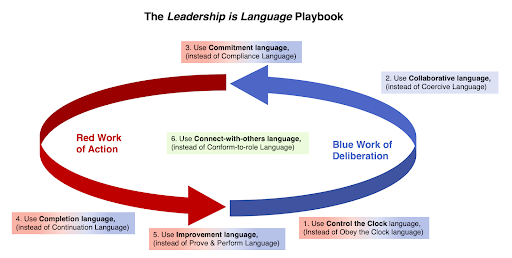Leadership is Language: How Our Leaders' Words Impact Our Thinking
In 2015, the container ship El Faro, tragically sank in the Caribbean Sea at the hands of hurricane Joaquin. When Search crews recovered the ship’s recorder, it told the bizarre tale of a captain and its crew that deliberately chose to “stay the course”, despite knowing the weather was changing for the worse.
How did this happen? Why did seasoned mariners ignore the dangers and plow directly into a dangerous and irresponsible situation? Why didn’t they choose to save their cargo, and their very lives?
These are the core questions of David Marquet’s recent book
Leadership is Language. Marquet asserts that what forced the captain to knowingly barrel forward into a hurricane is an all too common application for leaders and organizations: blindly “doing” when we should be thoughtfully “replanning”.
The Leader’s Bias to “Prove and Perform”
In the 511-page transcript of internal and external ship communication, the log shows a series of statements and questions that describe what psychologists call “Escalation of Commitment”.
It sounds like this…
- “We started this; we’re going to finish this.”
- “I’ve made my decision.”
- “We’re doing this. Resistance is futile.”
- “Come on, let’s go.”
- “We’re burning daylight.”
- “Failure is not an option.”
Do these sound familiar? Too many times in life and work, once we make a decision, we stubbornly stick to it, even in the face of mounting evidence that the decision is not working. Changing course means admitting we were wrong, and our limbic brains fear the consequences of being wrong.
This is why governments hold onto failing policies, why investors hold losing assets, why companies continue with failing products. We double down on these poor choices, to avoid shame, financial loss, and other things we often can’t even put into words.
Language Shifts Thinking
To overcome this mental bias, Marquet introduces a practice he calls “Control the Clock”, instead of blindly “obeying the clock”. Yes we all have deadlines and commitments. However, if leaders choose what they say, they can create the space for a pause. That pause allows us to reflect and review whether the current direction is right or wrong. For example…
A construction foreman accountable for schedule and safety can say: “I’m a bit nervous about the storm in the distance. We are going to start work, but we will revisit this decision at twelve. I’d like to learn about conditions on-site at eleven thirty, in support of that decision.”
An oil rig superintendent shifting his team into production mode can say:
“Let’s start pumping and I’ll check in in two hours.”
By formally scheduling checkpoints, we can minimize the escalation of the wrong commitment.
Too Much of a Good Thing
Now, I know what you overachievers are saying:
- Talk is cheap
- This leads to analysis paralysis
- We get paid to get it done
Yes. There is a point here. We’ve often seen the opposite of the spectrum where some leaders are frozen with indecision and nothing happens. Ever.
In this case, the fear of a wrong decision is not preventing a confrontation with a failing strategy. Instead, that same fear is preventing any decision on any strategy.
Therefore we need to avoid both extremes by cycling back and forth between these two mental modes. Inspired by Daniel Kahneman’s System 1 thinking versus System 2 thinking, Marquet introduces two mental models of work - redwork versus bluework:
Redwork is doing. Redwork is clockwork. Efficiency. Getting work done against the clock. It’s a prove-and-perform mindset. Variability is the enemy. This is Kahneman’s System 1 “Thinking Fast”.
Bluework is thinking. Bluework is cognitive work. It’s about creativity, decision-making, and it’s harder to measure. It’s an improve-and-learn mindset. Variability is an ally. This is Kahneman’s System 2 “Thinking Slow”.
In case it isn’t obvious yet, we need
both. Action
and reflection. Doing
and planning. Doing only redwork is spiraling in circles. Dwelling only on the bluework is just blowing wind.
Want to learn more about Marquet's redwork and bluework? Watch his three minute video.
How Leaders Playbook for “Right Thinking”
So what should leaders do? How do we know when or how to use the right kind of thinking? Marquet formulates a playbook of six moves to help a team or organization cycle smoothly between redwork and bluework.

For each move, he offers a set of contrasting phrases.






For my money, this is the most powerful part of the book. Most leaders I work with struggle with choosing the right words at the right time. They operate on instinct, and end up causing confusion, gridlock, or burnout.
Instead, Marquet gives us an explicit script for what to say to a team, at each step of the way.
The Agile Advantage
One encouraging surprise was Marquet’s vocal support of agile methods as a way to operationalize the balance of redwork and bluework. By using iterative cycles such as “Sprints”, teams have scheduled interruptions of their heads-down work, where they perform Reviews, Retrospectives, and Planning. This way, the red mode of get-it-done is balanced by intentional pauses to enter the blue mode of think-it-through.
This explains why problems arise when those blue mode agile events are so poorly run. If our reflective time is boring, poorly attended, rehashing the same old problems, then we aren’t getting the value of bluework, and we haplessly go back to the robotic burnout of redwork-as-usual.
Balancing and Blending Polarities
This contrasting of two modes of leadership is a core theme in our Agile Leadership Journey™ curriculum and community.
Our coaches favor the use of the
Competing Values Leadership framework (Cameron, Quinn, DeGraff, & Thakor). The framework describes how people and cultures can overemphasize Competition over Collaboration or Creativity over Control. Instead, the strongest organizations have intentional conversations about having the
right blend of the four values, relative to their missions and goals.
Additionally, Bill Joiner’s
Leadership Agility contrasts two opposing
power styles: Assertive Power that takes action and speaks up; versus Accommodative Power that features demonstrating curiosity and listening to others’ opinions. Most of us have a bias towards one or the other. However, Joiner’s research finds a correlation between higher leadership effectiveness scores, and a strong balance of both power styles.
At first glance, it seems fairly obvious that balancing opposites is a fairly universal form of mature practice and good advice. However what was energizing to me from this book is the notion that our language, our choice of words, can make the difference between a bias towards an extreme or a balance that yields results.
The next time you see a pattern of too much redwork or too much bluework, consider fostering the right language to break out of that phase, and into the other.
Take the next step
- Discover your power style—take our Leadership Power Style Survey
- Explore how the polarities in the Competing Values Framework can work together—take the Culture Values Quiz







